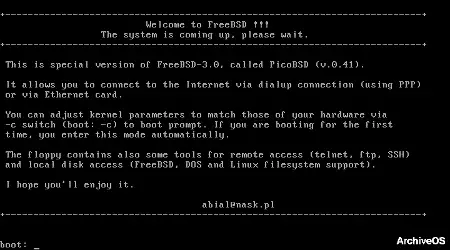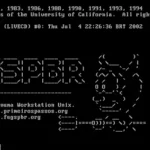Last Updated on: 28th May 2023, 12:11 pm
Web site: people.freebsd.org/~picobsd/old/picobsd.html
Origin: Poland
Category: Desktop
Desktop environment: CLI
Architecture: x86
Based on: FreeBSD
Wikipedia: PicoBSD
Media: Live Floppy
The last version | Released: 2.2.5 | March 26, 1998
PicoBSD – a one floppy version of FreeBSD, configured mainly for networking applications. It can be used as a router or firewall, or kind of a fixit floppy (or all of them).
Minimal requirements:
– 386SX CPU or better (there is an FPU emulator in kernel)
– 10MB RAM – the more the better. If you have an HDD, you can make a swap partition or swap file (using vnode driver and vnconfig). Then you probably will be able to run with ca. 6MB only
– Modem sitting on COM1-COM4 (default is to use COM2), if you want to have a PPP connection
– Network card: compatible with NE2000, PCI Intel, 3Com 3c509 or with DEC chipsets (ed, ep, fxp and de drivers). The kernel supports two of them (i.e. 7 total) plus two PPP connections (tun interfaces). So you can easily build something like router with as many as 9 outlets
The project developer is Andrzej Bialecki, and newer version is Dinesh Nair.
The latest floppies of version 0.42 were built from 3.0-current sources. Though they provide more features, they tend to be less stable than the latest RELEASE of FreeBSD. Dinesh Nair back-ported these scripts to the latest release (2.2.5), and continues development of PicoBSD using sources from that branch.
In April 2, 2005 Volker Ruppert created an ‘img’ image of PicoBSD. The directory contains a bootable floppy image of PicoBSD, which is a teeny version of FreeBSD. I have been able to get it to boot, as long as I tell it not to probe for a mouse.
PicoBSD is now included in the FreeBSD source files where it is used by embedded system developers to create their own system images. It can be used with recent versions of FreeBSD and it is located in /usr/src/release/picobsd/.
In FreeBSD 5, it has been superseded by the NanoBSD framework.



